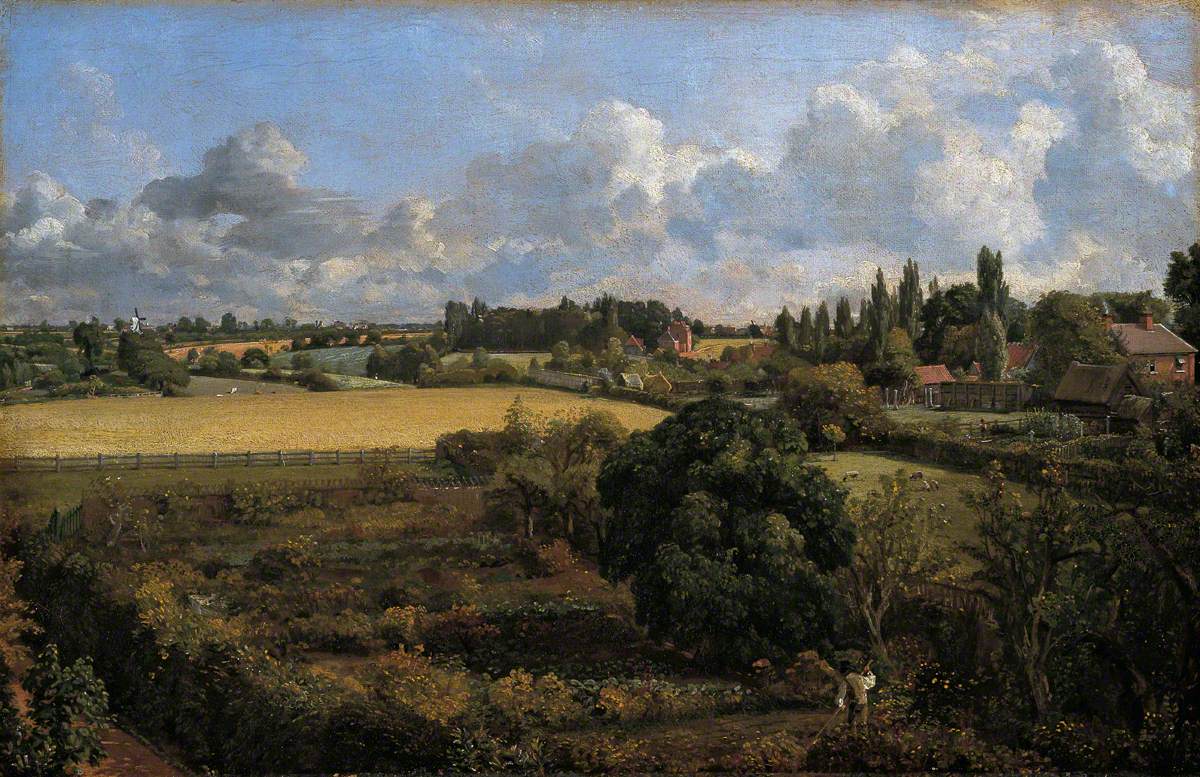John Constable, Golding Constable's Kitchen Garden, (1815), Ipswich Borough Council Collection
Christchurch Mansion, in Ipswich, is an absolute treasure, one of those traditional, local museums which attempts, and largely succeeds, in giving an accessible, potted cultural history - furnished rooms, children's toys, Victorian kitchens. It's all slightly down at heel, but so warmly staffed and so obviously well-intentioned, that you forgive the deficiencies. Given the recent decimation of local amenity and arts funding it's a miracle it's open at all.
The house itself is a stylish Tudor red brick, the roofline enlivened by a series of Dutch gables, the entrance aggrandised by columns and topped with a stunning octagonal clock face. It seems overloaded with windows, everything slightly off kilter. Once inside the entrance hall is impressive: double height, galleried, with a black and white tiled floor straight out of Vermeer and the usual array of family portraits joined by random copies of Renaissance sculpture. So far so predictable, but the house has some surprises up its sleeve. The Wingfield Room features spectacular oak panelling, not original but moved from a house in the centre of the town: the sixteenth century overmantel is quirkily and audaciously carved with nude figures of the Judgement of Paris and the Three Graces. The Upper Chamber, sagging under the weight of oak, contains sections of preserved plaster painting from several Ipswich houses. But the real treat, is the art collection: the house boasts some wonderful works by local artists, Thomas Gainsborough and John Constable.
At present some of the best of these are on show as part of Landscape Rebels in the Wolsey Art Gallery, a purpose-built exhibition space within the mansion. Hats off to the curators. This is a cleverly put together show, with something for everyone and a clear but never overly didactic determination to make you think about the climate crisis. There are 1960s floral print dresses, Victorian pinned moth collections, a lethal-looking shark-tooth spear and a range of artworks from seventeenth Dutch landscapes to contemporary commissions. You can go round and simply enjoy the objects or you can read the carefully written wall texts and think about coastal erosion, forest fires and industrial pollution.
If you were being picky, you might argue that Golding Constable's Kitchen Garden (1815), one of a pair of uncharacteristically precise paintings of his family home which Constable painted for himself and in memory of his parents, is not particularly rebellious, nor especially related to the climate crisis. The same could be said of Cedric Morris, another local lad, or indeed Walton Bridges (1806), one of those early Turner’s that harks back rather than looks forward. Equally, you could argue that the whole concept was a poor man’s version of last year’s Radical Landscapes at Tate Liverpool. But do I really care? This was a perfect balance of revisiting old friends - Philip Wilson Steer’s Knucklebones, Walberswick (1888-9) with its family beach holiday nostalgia of languor and awkwardness - and making new ones - Mary Warsop's Coastal Suffolk (1981) grey-green stack of landscapes in which sky and sea become interchangeable; or Guy William Eves' precise yet evocative 'tree portraits' (2020). And it gave you something to think about. In one room, with limited resources but real thought and care, the curators have put on a great exhibition. Given the wall of comments left at the end and the numbers I saw visiting, it's one which has clearly resonated with the public. I overheard people saying this was their third visit, and of course an added bonus is that it is a free show. Ipswich is a lucky town.



No comments:
Post a Comment